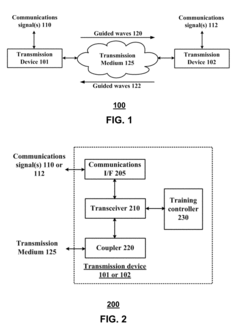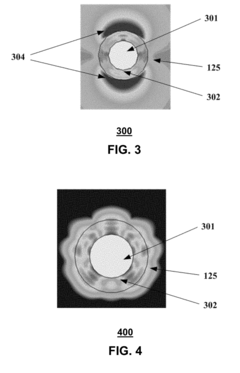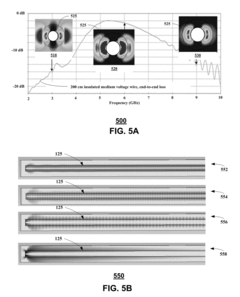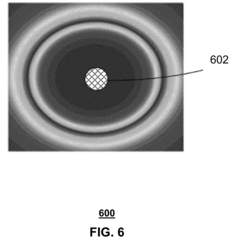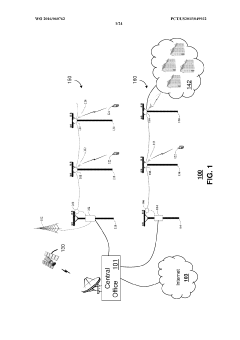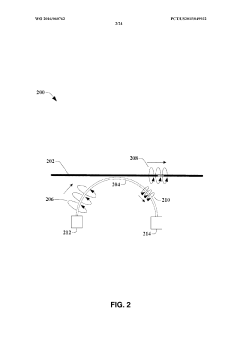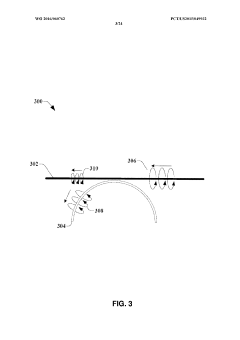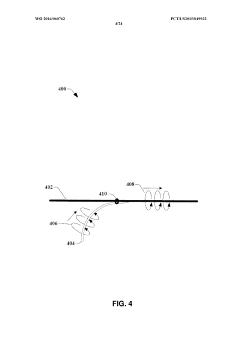Chiplet-based Designs: Supporting Mobile Broadband Expansion
JUL 16, 20259 MIN READ
Generate Your Research Report Instantly with AI Agent
Patsnap Eureka helps you evaluate technical feasibility & market potential.
Chiplet Technology Evolution and Objectives
Chiplet technology has emerged as a revolutionary approach in semiconductor design, offering a paradigm shift in how complex systems are built. The evolution of chiplets can be traced back to the early 2010s when the limitations of monolithic chip designs became increasingly apparent. As Moore's Law began to slow down, chiplets presented a viable solution to continue scaling performance and functionality.
The primary objective of chiplet-based designs is to overcome the challenges associated with traditional monolithic chip manufacturing. By disaggregating complex systems into smaller, more manageable components, chiplets allow for improved yield, reduced costs, and enhanced flexibility in system design. This approach is particularly relevant for supporting mobile broadband expansion, as it enables the creation of more powerful and efficient communication systems.
In the context of mobile broadband, chiplet technology aims to address several key goals. Firstly, it seeks to improve the integration of diverse functionalities required in modern mobile devices, such as baseband processing, RF components, and power management. Secondly, chiplets target the reduction of power consumption while increasing computational capabilities, a critical factor in extending battery life and enhancing user experience.
The evolution of chiplet technology has been marked by significant milestones. Initially, the focus was on developing reliable interconnect technologies to enable high-bandwidth, low-latency communication between chiplets. This led to the development of advanced packaging technologies such as 2.5D and 3D integration. Subsequently, efforts shifted towards standardizing chiplet interfaces, culminating in initiatives like the Universal Chiplet Interconnect Express (UCIe) consortium.
Looking forward, the objectives of chiplet technology in mobile broadband expansion are multifaceted. There is a push towards even finer granularity in chiplet design, allowing for more specialized and optimized components. Additionally, there is a growing emphasis on heterogeneous integration, combining chiplets manufactured using different process nodes to achieve the optimal balance of performance, power efficiency, and cost.
Another key objective is the development of more sophisticated design tools and methodologies specifically tailored for chiplet-based systems. This includes advanced simulation and modeling capabilities to optimize the interaction between different chiplets and predict system-level performance accurately. Furthermore, there is a focus on improving the thermal management and power distribution across chiplet-based designs, which is crucial for mobile applications.
In conclusion, the evolution of chiplet technology and its objectives are closely aligned with the demands of mobile broadband expansion. By enabling more powerful, efficient, and flexible system designs, chiplets are poised to play a pivotal role in shaping the future of mobile communication technologies.
The primary objective of chiplet-based designs is to overcome the challenges associated with traditional monolithic chip manufacturing. By disaggregating complex systems into smaller, more manageable components, chiplets allow for improved yield, reduced costs, and enhanced flexibility in system design. This approach is particularly relevant for supporting mobile broadband expansion, as it enables the creation of more powerful and efficient communication systems.
In the context of mobile broadband, chiplet technology aims to address several key goals. Firstly, it seeks to improve the integration of diverse functionalities required in modern mobile devices, such as baseband processing, RF components, and power management. Secondly, chiplets target the reduction of power consumption while increasing computational capabilities, a critical factor in extending battery life and enhancing user experience.
The evolution of chiplet technology has been marked by significant milestones. Initially, the focus was on developing reliable interconnect technologies to enable high-bandwidth, low-latency communication between chiplets. This led to the development of advanced packaging technologies such as 2.5D and 3D integration. Subsequently, efforts shifted towards standardizing chiplet interfaces, culminating in initiatives like the Universal Chiplet Interconnect Express (UCIe) consortium.
Looking forward, the objectives of chiplet technology in mobile broadband expansion are multifaceted. There is a push towards even finer granularity in chiplet design, allowing for more specialized and optimized components. Additionally, there is a growing emphasis on heterogeneous integration, combining chiplets manufactured using different process nodes to achieve the optimal balance of performance, power efficiency, and cost.
Another key objective is the development of more sophisticated design tools and methodologies specifically tailored for chiplet-based systems. This includes advanced simulation and modeling capabilities to optimize the interaction between different chiplets and predict system-level performance accurately. Furthermore, there is a focus on improving the thermal management and power distribution across chiplet-based designs, which is crucial for mobile applications.
In conclusion, the evolution of chiplet technology and its objectives are closely aligned with the demands of mobile broadband expansion. By enabling more powerful, efficient, and flexible system designs, chiplets are poised to play a pivotal role in shaping the future of mobile communication technologies.
Mobile Broadband Market Demand Analysis
The mobile broadband market has experienced significant growth in recent years, driven by increasing demand for high-speed internet connectivity on mobile devices. This trend is expected to continue as more consumers and businesses rely on mobile networks for data-intensive applications and services.
The global mobile broadband market is projected to expand substantially over the next decade. Factors contributing to this growth include the proliferation of smartphones and other connected devices, the rise of data-hungry applications such as video streaming and cloud computing, and the ongoing digital transformation across various industries.
In developed markets, the demand for mobile broadband is primarily driven by the need for faster and more reliable connections to support emerging technologies like augmented reality, virtual reality, and the Internet of Things (IoT). These applications require high bandwidth and low latency, pushing the limits of current mobile network capabilities.
Emerging markets present a significant opportunity for mobile broadband expansion. As smartphone adoption increases and internet penetration grows, there is a rising demand for affordable and accessible mobile broadband services. In many of these regions, mobile networks serve as the primary means of internet access, further emphasizing the importance of robust mobile broadband infrastructure.
The enterprise sector is another key driver of mobile broadband demand. Businesses are increasingly adopting mobile-first strategies, cloud-based services, and remote work policies, all of which rely heavily on reliable and high-speed mobile connectivity. This trend has been accelerated by the global shift towards remote work and digital collaboration tools.
The rollout of 5G networks is expected to be a major catalyst for mobile broadband market growth. 5G technology promises significantly faster speeds, lower latency, and increased network capacity compared to previous generations. This will enable new use cases and applications, further driving demand for mobile broadband services across various sectors.
However, the mobile broadband market also faces challenges. Network operators must invest heavily in infrastructure upgrades to meet growing demand and deploy new technologies like 5G. Additionally, spectrum scarcity and regulatory hurdles in some regions may impact the pace of mobile broadband expansion.
In conclusion, the mobile broadband market is poised for substantial growth, driven by increasing consumer and enterprise demand, technological advancements, and the expansion of digital services. The success of chiplet-based designs in supporting this expansion will be crucial in addressing the technical challenges associated with delivering high-performance, energy-efficient mobile broadband solutions to meet the evolving needs of the market.
The global mobile broadband market is projected to expand substantially over the next decade. Factors contributing to this growth include the proliferation of smartphones and other connected devices, the rise of data-hungry applications such as video streaming and cloud computing, and the ongoing digital transformation across various industries.
In developed markets, the demand for mobile broadband is primarily driven by the need for faster and more reliable connections to support emerging technologies like augmented reality, virtual reality, and the Internet of Things (IoT). These applications require high bandwidth and low latency, pushing the limits of current mobile network capabilities.
Emerging markets present a significant opportunity for mobile broadband expansion. As smartphone adoption increases and internet penetration grows, there is a rising demand for affordable and accessible mobile broadband services. In many of these regions, mobile networks serve as the primary means of internet access, further emphasizing the importance of robust mobile broadband infrastructure.
The enterprise sector is another key driver of mobile broadband demand. Businesses are increasingly adopting mobile-first strategies, cloud-based services, and remote work policies, all of which rely heavily on reliable and high-speed mobile connectivity. This trend has been accelerated by the global shift towards remote work and digital collaboration tools.
The rollout of 5G networks is expected to be a major catalyst for mobile broadband market growth. 5G technology promises significantly faster speeds, lower latency, and increased network capacity compared to previous generations. This will enable new use cases and applications, further driving demand for mobile broadband services across various sectors.
However, the mobile broadband market also faces challenges. Network operators must invest heavily in infrastructure upgrades to meet growing demand and deploy new technologies like 5G. Additionally, spectrum scarcity and regulatory hurdles in some regions may impact the pace of mobile broadband expansion.
In conclusion, the mobile broadband market is poised for substantial growth, driven by increasing consumer and enterprise demand, technological advancements, and the expansion of digital services. The success of chiplet-based designs in supporting this expansion will be crucial in addressing the technical challenges associated with delivering high-performance, energy-efficient mobile broadband solutions to meet the evolving needs of the market.
Chiplet Design Challenges in Mobile Networks
Chiplet-based designs present several significant challenges in the context of mobile networks, particularly as the industry strives to support the expansion of mobile broadband capabilities. One of the primary hurdles is the integration of diverse chiplets within a single package, each potentially manufactured using different process nodes. This heterogeneous integration demands advanced packaging technologies and intricate interconnect solutions to ensure seamless communication between chiplets while maintaining the performance and power efficiency required for mobile applications.
The thermal management of chiplet-based designs in mobile devices poses another critical challenge. As mobile networks evolve to support higher data rates and more complex processing, the power density within chiplets increases. This necessitates innovative cooling solutions that can effectively dissipate heat within the confined spaces of mobile devices, without compromising the form factor or user experience.
Signal integrity and power delivery become more complex in chiplet designs for mobile networks. The high-speed interfaces between chiplets must maintain signal quality over short distances, while minimizing crosstalk and electromagnetic interference. This is particularly challenging in the noise-sensitive environment of mobile devices, where multiple radio frequencies and digital signals coexist in close proximity.
The design and verification of chiplet-based systems for mobile networks also present unique challenges. Engineers must develop new methodologies to validate the functionality and performance of the entire system, including the interactions between chiplets and the package substrate. This requires advanced simulation tools and test strategies that can account for the complexities of multi-die integration.
Cost considerations play a crucial role in chiplet adoption for mobile networks. While chiplets offer potential cost benefits through the mix-and-match of different process nodes, the additional packaging and testing requirements can offset these savings. Balancing the cost-performance trade-offs becomes critical for widespread adoption in cost-sensitive mobile markets.
Standardization of chiplet interfaces and protocols is another significant challenge. The mobile industry requires interoperable solutions that can work across different vendors and generations of technology. Developing and adopting common standards for chiplet integration in mobile devices is essential for creating a robust ecosystem and ensuring long-term viability of the technology.
Lastly, the reliability and yield of chiplet-based designs in mobile networks present ongoing challenges. The increased number of interconnects and the complexity of multi-die packages introduce new failure modes that must be addressed to meet the stringent reliability requirements of mobile devices operating in diverse environmental conditions.
The thermal management of chiplet-based designs in mobile devices poses another critical challenge. As mobile networks evolve to support higher data rates and more complex processing, the power density within chiplets increases. This necessitates innovative cooling solutions that can effectively dissipate heat within the confined spaces of mobile devices, without compromising the form factor or user experience.
Signal integrity and power delivery become more complex in chiplet designs for mobile networks. The high-speed interfaces between chiplets must maintain signal quality over short distances, while minimizing crosstalk and electromagnetic interference. This is particularly challenging in the noise-sensitive environment of mobile devices, where multiple radio frequencies and digital signals coexist in close proximity.
The design and verification of chiplet-based systems for mobile networks also present unique challenges. Engineers must develop new methodologies to validate the functionality and performance of the entire system, including the interactions between chiplets and the package substrate. This requires advanced simulation tools and test strategies that can account for the complexities of multi-die integration.
Cost considerations play a crucial role in chiplet adoption for mobile networks. While chiplets offer potential cost benefits through the mix-and-match of different process nodes, the additional packaging and testing requirements can offset these savings. Balancing the cost-performance trade-offs becomes critical for widespread adoption in cost-sensitive mobile markets.
Standardization of chiplet interfaces and protocols is another significant challenge. The mobile industry requires interoperable solutions that can work across different vendors and generations of technology. Developing and adopting common standards for chiplet integration in mobile devices is essential for creating a robust ecosystem and ensuring long-term viability of the technology.
Lastly, the reliability and yield of chiplet-based designs in mobile networks present ongoing challenges. The increased number of interconnects and the complexity of multi-die packages introduce new failure modes that must be addressed to meet the stringent reliability requirements of mobile devices operating in diverse environmental conditions.
Current Chiplet Solutions for Mobile Broadband
01 Chiplet interconnection and integration
Chiplet-based designs focus on interconnecting multiple smaller chips (chiplets) to create larger, more complex systems. This approach involves developing advanced packaging technologies and interconnect solutions to efficiently integrate chiplets, enabling modular and scalable chip designs. The integration methods may include interposers, advanced substrates, or direct chip-to-chip connections.- Chiplet interconnection and integration: Chiplet-based designs focus on interconnecting multiple smaller chips (chiplets) to create larger, more complex systems. This approach involves developing advanced packaging technologies and interconnect solutions to efficiently integrate chiplets with different functionalities. The integration methods aim to optimize performance, power consumption, and manufacturing costs while enabling scalable and flexible chip designs.
- Thermal management in chiplet designs: Effective thermal management is crucial in chiplet-based designs due to the high power density and heat generation in compact multi-chip packages. Innovative cooling solutions, such as integrated heat spreaders, microchannel cooling, and advanced thermal interface materials, are developed to maintain optimal operating temperatures and ensure reliable performance of chiplet-based systems.
- Power distribution and management for chiplets: Efficient power distribution and management are essential in chiplet-based designs to ensure stable operation and minimize power consumption. This involves developing advanced power delivery networks, voltage regulation techniques, and power gating strategies tailored for multi-chip architectures. The goal is to optimize power efficiency while maintaining performance across the integrated chiplets.
- Chiplet-based memory and storage solutions: Chiplet technology is applied to memory and storage systems to improve capacity, bandwidth, and energy efficiency. This approach involves integrating multiple memory chiplets or combining memory and logic chiplets to create high-performance, scalable memory solutions. Advanced packaging and interconnect technologies are utilized to optimize data transfer rates and reduce latency in chiplet-based memory architectures.
- Testing and yield improvement for chiplet designs: Developing effective testing methodologies and yield improvement techniques is crucial for chiplet-based designs. This includes pre-bond and post-bond testing strategies, fault isolation techniques, and redundancy schemes to enhance overall system yield. Advanced diagnostic tools and adaptive testing approaches are employed to ensure the reliability and quality of integrated chiplet systems.
02 Power management in chiplet designs
Efficient power management is crucial in chiplet-based designs. This includes developing strategies for distributing power across multiple chiplets, implementing power gating techniques, and optimizing power delivery networks. Advanced power management solutions aim to reduce overall power consumption while maintaining performance in multi-chiplet systems.Expand Specific Solutions03 Thermal management for chiplet architectures
Thermal management is a critical aspect of chiplet-based designs, especially as chiplet integration densities increase. This involves developing innovative cooling solutions, thermal interface materials, and heat spreading techniques to efficiently dissipate heat from multiple chiplets in a compact package. Effective thermal management ensures reliable operation and optimal performance of chiplet-based systems.Expand Specific Solutions04 Communication protocols for inter-chiplet data transfer
Developing efficient and high-bandwidth communication protocols is essential for chiplet-based designs. This includes creating standardized interfaces and protocols for data transfer between chiplets, implementing advanced signaling techniques, and optimizing data routing strategies. These protocols aim to minimize latency and maximize data throughput in multi-chiplet systems.Expand Specific Solutions05 Testing and validation of chiplet-based systems
Ensuring the reliability and functionality of chiplet-based designs requires advanced testing and validation methodologies. This involves developing techniques for testing individual chiplets, verifying inter-chiplet connections, and validating the overall system performance. Test strategies may include built-in self-test features, advanced probe technologies, and system-level validation approaches tailored for multi-chiplet architectures.Expand Specific Solutions
Key Players in Chiplet and Mobile Broadband Industries
The chiplet-based design market for mobile broadband expansion is in a growth phase, with increasing market size and technological advancements. Major players like Qualcomm, Intel, and Samsung are driving innovation in this space, leveraging their expertise in semiconductor design and mobile technologies. The market is characterized by intense competition and rapid technological evolution, with companies like ZTE, LG Electronics, and Sony also making significant contributions. As the technology matures, we're seeing increased adoption and integration across various mobile devices, indicating a promising future for chiplet-based designs in supporting the expansion of mobile broadband capabilities.
ZTE Corp.
Technical Solution: ZTE's approach to chiplet-based designs for mobile broadband expansion is evident in their 5G base station solutions. The company has developed a series of chipsets, including their ZXC800 series, which utilize modular designs to support flexible 5G network deployments. ZTE's chiplet strategy focuses on separating the baseband processing unit, radio frequency unit, and antenna systems into distinct modules that can be easily integrated or upgraded. This approach allows for more efficient power management and thermal control in base stations, crucial for the high-performance requirements of 5G networks. ZTE has demonstrated their chiplet-based solutions in large-scale 5G deployments, showcasing the ability to support multi-band, multi-RAT (Radio Access Technology) operations[11]. The company's chiplet designs also incorporate AI acceleration capabilities, enabling intelligent network optimization and dynamic resource allocation to improve overall network efficiency and user experience[12].
Strengths: Strong presence in telecom infrastructure, experience in large-scale network deployments, and integrated solutions from chips to systems. Weaknesses: Potential geopolitical challenges in some markets, and competition from more established chipset providers in the mobile device segment.
QUALCOMM, Inc.
Technical Solution: Qualcomm's chiplet-based design for mobile broadband expansion focuses on their Snapdragon X65 5G Modem-RF System. This system utilizes a modular architecture that separates the modem, RF transceiver, and antenna modules into distinct chiplets. The design supports up to 10 Gbps peak download speeds and implements advanced features like Smart Transmit 2.0 for improved thermal efficiency[1]. Qualcomm's approach allows for flexible integration of 5G capabilities across diverse device form factors, from smartphones to fixed wireless access points. The chiplet design enables easier customization and upgradeability, potentially reducing time-to-market for OEMs adopting 5G technology[2]. Additionally, Qualcomm's solution incorporates AI-enhanced signal optimization and dynamic spectrum sharing, further improving network performance and efficiency in congested urban environments[3].
Strengths: Industry-leading 5G modem technology, extensive ecosystem partnerships, and proven track record in mobile chipsets. Weaknesses: Potential challenges in maintaining performance consistency across different chiplet configurations and increased complexity in system integration.
Core Innovations in Chiplet-based Mobile SoCs
Method and apparatus for use with a radio distributed antenna system having an ultra-wideband control channel
PatentActiveUS20190037573A1
Innovation
- A guided wave communication system that utilizes electromagnetic waves bound to a transmission medium, such as wires, to propagate signals without the need for an electrical return path, enabling efficient data transmission over long distances with reduced loss, and includes coupling devices to launch and extract these waves at millimeter-wave frequencies.
Method and apparatus for transmitting or receiving signals in a transportation system via surface waves over power lines
PatentWO2016060762A1
Innovation
- A guided wave communication system using a dielectric waveguide coupler that facilitates the transmission and reception of electromagnetic waves along power lines, enabling increased network connectivity by converting millimeter-wave signals into guided waves that propagate as surface waves on utility wires.
Standardization Efforts in Chiplet Designs
Standardization efforts in chiplet designs have become increasingly crucial as the industry moves towards more modular and flexible semiconductor architectures. These efforts aim to establish common interfaces, protocols, and design methodologies that enable seamless integration of diverse chiplets from different manufacturers. The JEDEC Solid State Technology Association has been at the forefront of these initiatives, developing standards such as the Universal Chiplet Interconnect Express (UCIe) specification.
The UCIe standard, released in March 2022, defines a die-to-die interconnect that allows chiplets from various vendors to communicate effectively within a single package. This specification covers both the physical layer and the protocol layer, ensuring interoperability across different chiplet designs. The adoption of UCIe by major industry players, including Intel, AMD, Arm, and TSMC, underscores its significance in shaping the future of chiplet-based architectures.
Another important standardization effort is the Open Compute Project's (OCP) Bunch of Wires (BoW) interface. BoW aims to provide a simple, cost-effective die-to-die interface suitable for both organic and silicon interposers. This standard complements UCIe by offering a more accessible option for smaller companies and academic institutions to participate in chiplet-based design ecosystems.
The Advanced Interface Bus (AIB) consortium, led by Intel, has also been working on standardizing chiplet interconnects. AIB focuses on high-bandwidth, low-latency connections between chiplets, which is particularly relevant for mobile broadband applications that require efficient data transfer between processing units and memory components.
Standardization efforts extend beyond interconnects to encompass design methodologies and verification processes. The Accellera Systems Initiative has been developing standards for system-level design and verification, which are essential for ensuring the reliability and performance of complex chiplet-based systems. These standards include SystemC and Universal Verification Methodology (UVM), which provide frameworks for modeling and verifying chiplet designs at various abstraction levels.
As mobile broadband expansion continues to drive demand for more powerful and efficient semiconductor solutions, these standardization efforts play a crucial role in enabling the widespread adoption of chiplet-based designs. By establishing common protocols and interfaces, the industry can foster innovation, reduce development costs, and accelerate time-to-market for new mobile broadband technologies.
The UCIe standard, released in March 2022, defines a die-to-die interconnect that allows chiplets from various vendors to communicate effectively within a single package. This specification covers both the physical layer and the protocol layer, ensuring interoperability across different chiplet designs. The adoption of UCIe by major industry players, including Intel, AMD, Arm, and TSMC, underscores its significance in shaping the future of chiplet-based architectures.
Another important standardization effort is the Open Compute Project's (OCP) Bunch of Wires (BoW) interface. BoW aims to provide a simple, cost-effective die-to-die interface suitable for both organic and silicon interposers. This standard complements UCIe by offering a more accessible option for smaller companies and academic institutions to participate in chiplet-based design ecosystems.
The Advanced Interface Bus (AIB) consortium, led by Intel, has also been working on standardizing chiplet interconnects. AIB focuses on high-bandwidth, low-latency connections between chiplets, which is particularly relevant for mobile broadband applications that require efficient data transfer between processing units and memory components.
Standardization efforts extend beyond interconnects to encompass design methodologies and verification processes. The Accellera Systems Initiative has been developing standards for system-level design and verification, which are essential for ensuring the reliability and performance of complex chiplet-based systems. These standards include SystemC and Universal Verification Methodology (UVM), which provide frameworks for modeling and verifying chiplet designs at various abstraction levels.
As mobile broadband expansion continues to drive demand for more powerful and efficient semiconductor solutions, these standardization efforts play a crucial role in enabling the widespread adoption of chiplet-based designs. By establishing common protocols and interfaces, the industry can foster innovation, reduce development costs, and accelerate time-to-market for new mobile broadband technologies.
Energy Efficiency of Chiplet-based Mobile Solutions
Energy efficiency is a critical factor in the development and adoption of chiplet-based mobile solutions. As mobile broadband continues to expand, the demand for more powerful and efficient devices increases. Chiplet-based designs offer a promising approach to address these challenges by enabling modular and scalable architectures that can optimize power consumption while delivering high performance.
One of the key advantages of chiplet-based designs in mobile solutions is their ability to integrate heterogeneous components efficiently. By separating different functional blocks into individual chiplets, manufacturers can optimize each component for its specific task, leading to improved overall energy efficiency. This modular approach allows for the use of the most suitable process technology for each chiplet, resulting in better power management across the entire system.
The interconnect technology used in chiplet-based designs plays a crucial role in energy efficiency. Advanced packaging techniques, such as 2.5D and 3D integration, enable high-bandwidth, low-latency communication between chiplets while minimizing power consumption. These interconnects reduce the energy required for data transfer between components, contributing to the overall energy efficiency of the mobile solution.
Chiplet-based designs also offer flexibility in power management strategies. By implementing fine-grained power control at the chiplet level, mobile devices can dynamically adjust power consumption based on workload and user requirements. This adaptive approach ensures that energy is allocated efficiently across the system, extending battery life and improving the user experience.
Furthermore, the scalability of chiplet-based designs allows for more efficient thermal management in mobile devices. By distributing heat-generating components across multiple chiplets, designers can optimize thermal dissipation and reduce the need for aggressive cooling solutions. This not only contributes to energy efficiency but also enables thinner and lighter device form factors.
As mobile broadband networks evolve towards 5G and beyond, chiplet-based designs are well-positioned to support the increasing demands for processing power and energy efficiency. The modular nature of chiplets allows for easier integration of new technologies, such as AI accelerators or specialized communication modules, without redesigning the entire system. This adaptability ensures that mobile devices can keep pace with network advancements while maintaining optimal energy efficiency.
In conclusion, the energy efficiency of chiplet-based mobile solutions offers significant advantages for supporting mobile broadband expansion. By leveraging modular architectures, advanced packaging technologies, and intelligent power management strategies, chiplet-based designs enable the development of high-performance, energy-efficient mobile devices that can meet the growing demands of next-generation mobile broadband networks.
One of the key advantages of chiplet-based designs in mobile solutions is their ability to integrate heterogeneous components efficiently. By separating different functional blocks into individual chiplets, manufacturers can optimize each component for its specific task, leading to improved overall energy efficiency. This modular approach allows for the use of the most suitable process technology for each chiplet, resulting in better power management across the entire system.
The interconnect technology used in chiplet-based designs plays a crucial role in energy efficiency. Advanced packaging techniques, such as 2.5D and 3D integration, enable high-bandwidth, low-latency communication between chiplets while minimizing power consumption. These interconnects reduce the energy required for data transfer between components, contributing to the overall energy efficiency of the mobile solution.
Chiplet-based designs also offer flexibility in power management strategies. By implementing fine-grained power control at the chiplet level, mobile devices can dynamically adjust power consumption based on workload and user requirements. This adaptive approach ensures that energy is allocated efficiently across the system, extending battery life and improving the user experience.
Furthermore, the scalability of chiplet-based designs allows for more efficient thermal management in mobile devices. By distributing heat-generating components across multiple chiplets, designers can optimize thermal dissipation and reduce the need for aggressive cooling solutions. This not only contributes to energy efficiency but also enables thinner and lighter device form factors.
As mobile broadband networks evolve towards 5G and beyond, chiplet-based designs are well-positioned to support the increasing demands for processing power and energy efficiency. The modular nature of chiplets allows for easier integration of new technologies, such as AI accelerators or specialized communication modules, without redesigning the entire system. This adaptability ensures that mobile devices can keep pace with network advancements while maintaining optimal energy efficiency.
In conclusion, the energy efficiency of chiplet-based mobile solutions offers significant advantages for supporting mobile broadband expansion. By leveraging modular architectures, advanced packaging technologies, and intelligent power management strategies, chiplet-based designs enable the development of high-performance, energy-efficient mobile devices that can meet the growing demands of next-generation mobile broadband networks.
Unlock deeper insights with Patsnap Eureka Quick Research — get a full tech report to explore trends and direct your research. Try now!
Generate Your Research Report Instantly with AI Agent
Supercharge your innovation with Patsnap Eureka AI Agent Platform!
